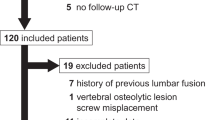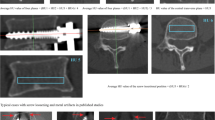Abstract
Purpose
The authors recently proposed the novel radiologic assessment method to measure chronological screw position changes precisely. The aim of this study was to predict the late occurrence of screw loosening, which was diagnosed by the radiographic lucent zone, by evaluating screw position changes at an early postoperative stage using the novel method.
Methods
Forty-three patients who underwent thoracolumbar screw fixation and follow-up computed tomography (CT) scans on the day, between 1 and 5 weeks, and at more than 6 months after surgery were retrospectively evaluated. Screw images were generated from CT data. Screw position changes were evaluated by superposing screw images on the day and between 1 and 5 weeks after surgery. Screw loosening was diagnosed by the radiographic lucent zone on CT images at 6 months or later post-surgery, and patients were classified into screw loosening and non-loosening groups. The early screw position changes were compared between the two groups.
Results
Significant differences in early screw position changes were found between the screw loosening and non-loosening groups in Mann–Whitney U test (p = 0.001). On the receiver operating characteristic (ROC) curve analysis, the area under the ROC curve was 0.791, and the best cutoff value of early screw position change for the prediction of screw loosening was 0.83 mm with a sensitivity of 64.0% and a specificity of 88.9%.
Conclusion
We calculated a cutoff value of the screw position changes at an early postoperative stage for the prediction of subsequent development of screw loosening with the radiographic lucent zone.



Similar content being viewed by others
References
Galbusera F, Volkheimer D, Reitmaier S et al (2015) Pedicle screw loosening: a clinically relevant complication? Eur Spine J 24:1005–1016
Spirig JM, Sutter R, Götschi T et al (2019) Value of standard radiographs, computed tomography, and magnetic resonance imaging of the lumbar spine in detection of intraoperatively confirmed pedicle screw loosening-a prospective clinical trial. Spine J 19:461–468
Tokuhashi Y, Matsuzaki H, Oda H et al (2008) Clinical course and significance of the clear zone around the pedicle screws in the lumbar degenerative disease. Spine (Phila Pa 1976) 33:903–908
Bokov A, Bulkin A, Aleynik A et al (2019) Pedicle screws loosening in patients with degenerative diseases of the lumbar spine: potential risk factors and relative contribution. Glob Spine J 9:55–61
Sakai Y, Takenaka S, Matsuo Y et al (2018) Hounsfield unit of screw trajectory as a predictor of pedicle screw loosening after single level lumbar interbody fusion. J Orthop Sci 23:734–738
Bredow J, Boese CK, Werner CML et al (2016) Predictive validity of preoperative CT scans and the risk of pedicle screw loosening in spinal surgery. Arch Orthop Trauma Surg 136:1063–1067
Sandén B, Olerud C, Petrén-Mallmin M et al (2004) The significance of radiolucent zones surrounding pedicle screws. Definition of screw loosening in spinal instrumentation. J Bone Jt Surg Br 86:457–461
Dakhil-Jerew F, Jadeja H, Cohen A et al (2009) Inter-observer reliability of detecting Dynesys pedicle screw using plain X-rays: a study on 50 post-operative patients. Eur Spine J 18:1486–1493
Okuyama K, Abe E, Suzuki T et al (2001) Influence of bone mineral density on pedicle screw fixation. Spine J 1:402–407
Ohtori S, Inoue G, Orita S et al (2013) Comparison of teriparatide and bisphosphonate treatment to reduce pedicle screw loosening after lumbar spinal fusion surgery in postmenopausal women with osteoporosis from a bone quality perspective. Spine (Phila Pa 1976) 38:487–492
Tanioka S, Ishida F, Kuraishi K et al (2019) A novel radiological assessment of screw loosening focusing on spatial position change of screws using an iterative closest point algorithm with stereolithography data: technical note. World Neurosurg 124:171–177
Schatzker J, Horne JG, Sumner-Smith G (1975) The effect of movement on the holding power of screws in bone. Clin Orthop Relat Res 111:257–262
Besl PJ, McKay ND (1992) A method for registration of 3-D shapes. IEEE Trans Pattern Anal Mach Intell 14:239–256
Mora H, Mora-Pascual JM, García-García A et al (2016) Computational analysis of distance operators for the iterative closest point algorithm. PLoS ONE 11:e0164694
Kanda Y (2013) Investigation of the freely available easy-to-use software “EZR” for medical statistics. Bone Marrow Transpl 48:452–458
Akobeng AK (2007) Understanding diagnostic tests 3: receiver operating characteristic curves. Acta Paediatr 96:644–647
Aghayev E, Zullig N, Diel P et al (2014) Development and validation of a quantitative method to assess pedicle screw loosening in posterior spine instrumentation on plain radiographs. Eur Spine J 23:689–694
Hudyana H, Maes A, Vandenberghe T et al (2016) Accuracy of bone SPECT/CT for identifying hardware loosening in patients who underwent lumbar fusion with pedicle screws. Eur J Nucl Med Mol Imaging 43:349–354
Funding
None.
Author information
Authors and Affiliations
Corresponding author
Ethics declarations
Conflict of interest
Satoru Tanioka, Masashi Fujimoto, Hirofumi Nishikawa, Fujimaro Ishida, Masanori Tsuji, Katsuhiro Tanaka, Yusuke Kamei, Keita Kuraishi, Hidenori Suzuki, and Masaki Mizuno declare that they have no conflict of interest.
Ethical approval
All procedures performed in studies involving human participants were in accordance with the ethical standards of the institutional research committee (Mie Chuo Medical Center IRB [MCERB-201848] and Mie University Hospital IRB [T2019-6]) and with the 1964 Helsinki declaration and its later amendments or comparable ethical standards.
Additional information
Publisher's Note
Springer Nature remains neutral with regard to jurisdictional claims in published maps and institutional affiliations.
Rights and permissions
About this article
Cite this article
Tanioka, S., Fujimoto, M., Nishikawa, H. et al. A screw position change at an early postoperative stage preceding the subsequent occurrence of screw loosening. Eur Spine J 30, 136–141 (2021). https://doi.org/10.1007/s00586-020-06510-8
Received:
Revised:
Accepted:
Published:
Issue Date:
DOI: https://doi.org/10.1007/s00586-020-06510-8




